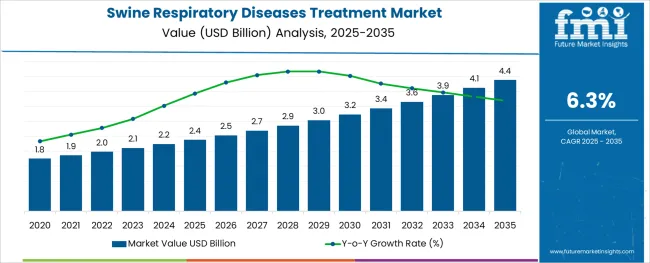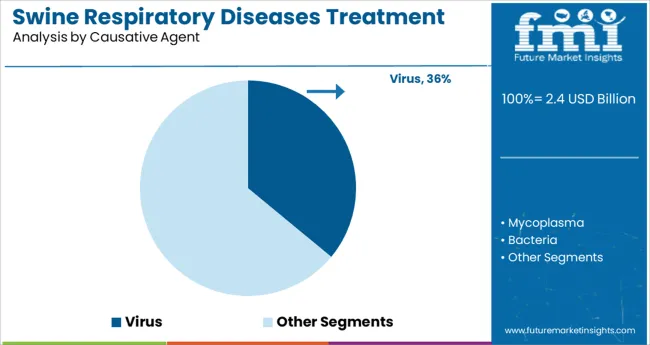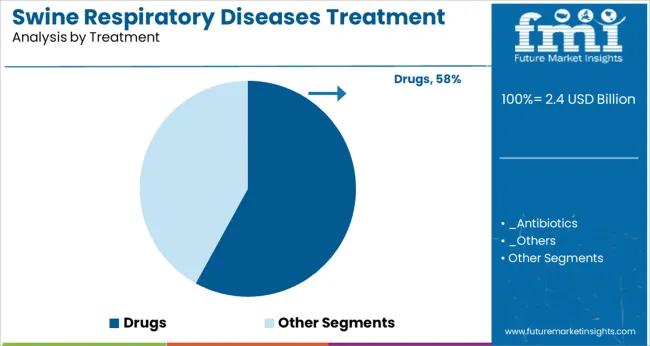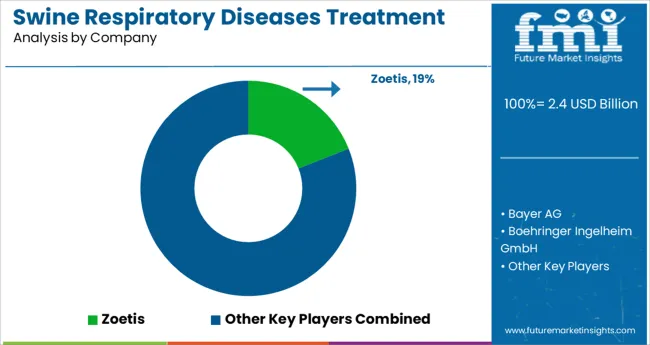The Swine Respiratory Diseases Treatment Market is estimated to be valued at USD 2.4 billion in 2025 and is projected to reach USD 4.4 billion by 2035, registering a compound annual growth rate (CAGR) of 6.3% over the forecast period.

The swine respiratory diseases treatment market is advancing due to rising incidence of respiratory infections, improved veterinary diagnostic capabilities, and heightened focus on biosecurity in commercial swine operations. Increasing concerns over productivity loss, mortality rates, and zoonotic threats have prompted swine producers to invest in advanced treatment protocols and early-stage interventions.
Governments and veterinary organizations are actively implementing disease control frameworks and surveillance systems, reinforcing the need for timely treatment access. Growing awareness about antimicrobial stewardship is also influencing treatment choices, with increased adoption of precision medication and targeted therapeutics.
As swine farming continues to expand globally, particularly in Asia and Latin America, demand for standardized and scalable treatment solutions is projected to grow. Technological progress in delivery systems and pharmaceutical formulations is expected to support the market's evolution, alongside sustained investments in swine health R&D.
The market is segmented by Causative Agent, Treatment, Route of Administration, and Distribution Channel and region. By Causative Agent, the market is divided into Virus, Mycoplasma, Bacteria, and Others. In terms of Treatment, the market is classified into Drugs and Vaccines. Based on Route of Administration, the market is segmented into Parenteral and Oral.
By Distribution Channel, the market is divided into Veterinary Hospitals, Veterinary Clinics, Pharmacies, and Others. Regionally, the market is classified into North America, Latin America, Western Europe, Eastern Europe, Balkan & Baltic Countries, Russia & Belarus, Central Asia, East Asia, South Asia & Pacific, and the Middle East & Africa.

Viruses are projected to account for 36.00% of the total swine respiratory diseases treatment market revenue in 2025, making them the most prominent causative agent. This dominance is being driven by the high prevalence of viral pathogens such as PRRSV, swine influenza, and circoviruses, which contribute significantly to respiratory distress in pig populations.
These infections often lead to secondary bacterial complications, amplifying treatment complexity and economic burden. As outbreaks increase in frequency and virulence, veterinarians and producers have prioritized viral diagnostics and intervention strategies.
The development of virus-specific antivirals and improved vaccine delivery platforms has further reinforced this segment's market share. Enhanced surveillance programs and global trade implications linked to viral respiratory conditions have also driven continuous monitoring and rapid response efforts across swine production regions.

Drugs are expected to capture 58.00% of the revenue share in the swine respiratory diseases treatment market by 2025, positioning them as the leading treatment option. This is attributed to their rapid efficacy, ease of integration into routine herd health protocols, and availability of broad-spectrum formulations.
Antiviral and antibacterial drugs are commonly administered to control disease progression and minimize mortality, especially in large-scale farming operations where timely interventions are critical. The segment has benefited from ongoing innovation in combination therapies, residue-free formulations, and drugs tailored for age-specific dosing.
Growing pressure to reduce antibiotic misuse has also led to strategic drug use under veterinary guidance, reinforcing compliance with animal health regulations. Furthermore, increasing resistance management initiatives are promoting responsible and monitored drug administration, ensuring continued effectiveness and market reliance.

Parenteral administration is forecast to lead the market with a 65.00% share in 2025, underscoring its role as the preferred delivery method in acute respiratory treatments. This route ensures rapid systemic absorption and immediate therapeutic effect, making it especially valuable in high-risk or outbreak scenarios.
Parenteral formulations allow for precise dosing and reduced variability in bioavailability, which is critical for ensuring treatment success in commercial herds. Veterinary practitioners favor this method for its reliability and controllability in field conditions, particularly in settings with poor oral intake due to illness.
Advancements in injectable drug formulations, including long-acting and depot injections, are enhancing convenience and reducing the frequency of administration. As biosecurity protocols become more rigorous, the demand for fast-acting, low-touch treatment methods like parenteral delivery is expected to remain strong across intensive swine production environments.
The global swine respiratory diseases treatment market held approximately 1.9% of the overall veterinary services market, which was worth ~USD 2.2 Billion in 2024. Sales of swine respiratory disease treatment services expanded at a CAGR of 6.1% from 2012 to 2024.
Demand for swine respiratory disease treatment options is on the rise due to the increasing number of foodborne and zoonotic diseases. According to the most recent annual report on food diseases issued by the European Food Safety Authority (EFSA) and the European Center for Disease Prevention and Control (ECDC) in February 2024, foodborne infections are on the rise compared to the previous year, with pathogenic bacteria such as campylobacter spp. being the most common cause.
Around 5175 food outbreaks were documented, accounting for 49463 clinical cases, 3859 hospital admissions, and 60 deaths (+50% compared to the previous year). Salmonella, norovirus, escherichia coli, yersinia enterocolitica, cryptosporidium parvum, and campylobacter jejuni were the most common etiological agents found, while the most common causes of infection were eggs & egg products, bakery items, hog meat, processed foods, water, crustaceans, and vegetables.
Additionally, the market for swine respiratory diseases treatment is anticipated to grow in terms of research & development (R&D) spending and revenue owing to external partnerships and strategic alliances between industries and academia.
For instance, in September 2025, Zoetis acquired NewMetrica, which had developed cutting-edge digital instruments in the form of standardized questionnaires that were intended to evaluate health-related quality of life (HRQL) in nonverbal species, as a strategic addition to their companion animal portfolio. Thus, owing to the aforementioned factors, the global swine respiratory diseases treatment market is expected to grow at a CAGR of 6.3% during the forecast period from 2025 to 2035.
Government Investments to Boost Access to Advanced Treatment Will Aid Growth
The market is likely to provide an opportunistic perspective owing to various initiatives by governments in emerging countries. Government bodies are investing significantly in healthcare infrastructure modernization, which is expected to bolster access to advanced healthcare services. This factor is set to fuel demand for upgraded technologies, thereby creating an appealing opportunity in the global swine respiratory diseases treatment market.
In high-income economies like the UK and the USA, there will likely be a greater emphasis on innovation to prevent zoonotic diseases combined with biotechnology breakthroughs, which will create a favorable environment for the development of veterinary therapeutics. These methods include systems biology, synthetic biology, and next-generation sequencing among others. Additionally, maintaining investments in multidisciplinary research may accelerate the time to market for new products and enhance the efficiency of therapy development.
The large market potential for veterinary therapeutics is expected to emerge throughout the forecast period as a result of growing economies in emerging markets like Latin America and Asia Pacific. The potential that these markets present are due to a large number of factors, including the increasing cost of living for the urban middle-class population in these regions, which further surges per-capita meat consumption and fuels the need for more effective livestock farming.
Stringent regulations put forward by the USA Food & Drug Administration (FDA) to limit the use of antibiotics for farm animals and the rising cost of innovation-dampening Research and Development investments can hamper the market in the forecast period. If antibiotics are administered to livestock that is raised for food such as swine and other animals, they may lose their efficacy in humans. Antibiotic-resistant bacteria known as superbugs are on the rise as a result of the widespread use of antibiotics in both humans and animals.
The cost of drug innovation has been increasing, as compared to earlier years. The trend is similar for animal healthcare. This is primarily attributed to a limited scope of research for newer diseases in livestock animals. Due to this, drug makers are investing more in the development of innovative drugs for diseases, which are already highly mature. This further raises Research and Development spending and dampens return on investment (ROI). These factors cumulatively propose a negative effect on developmental growth in the swine respiratory diseases treatment market.
Rising Prevalence of Zoonotic Diseases in the USA to Push Growth by 2035
The USA dominates the North American swine respiratory diseases treatment market and held a total share of about 52.9% in 2024. It is expected to continue to experience the same growth rate throughout the forecast period.
Owing to the increased swine respiratory diseases related deaths, high consumption of animal meats, and growing prevalence of zoonotic diseases, producers or manufacturers operating in the market are presented with new growth opportunities to develop unique preventive measures, which would further boost the market in the USA
Surging Need for H1N1 Influenza Treatment in Canada to Drive the Industry Forward
Canada held approximately 47.1% of the share in the North American swine respiratory diseases treatment market in 2024 and it is expected to showcase growth at a lucrative CAGR of 6.7% during the forecast period.
Influenza viruses are frequently found in pigs, who can be infected by humans, birds, or other pigs. Predominant influenza subtypes prevalent in pigs in Canada are H1N1, H1N2, and h4N2. Swine influenza viruses do not generally infect humans; however, these viruses have occasionally infected humans.
Cases mainly emerge because of direct or indirect contact with pigs in numerous settings such as farms or agricultural fairs. The Canadian Food Inspection Agency (CFIA) advises veterinarians and producers to maintain strict biosecurity measures to reduce any hazards to human or animal health.
Rising Cases of Swine Fever in Pigs to Propel Growth in Germany by 2035
Germany is set to exhibit a CAGR of nearly 5.8% in the Europe swine respiratory diseases treatment market during the forecast period. Germany is becoming increasingly popular when it comes to health and innovation. With the surging prevalence of influenza A (H1), as well as increasing surveillance and management measures of the disease implemented by the World Health Organization (WHO), the demand for swine respiratory disease treatment options will grow at a rapid pace.
Mycoplasma-based Swine Diseases to Exhibit High Growth in the Upcoming Decade
Mycoplasma-based causative agents are expected to witness high growth at a CAGR of 6.1% by the end of the forecast period. The segment held a swine respiratory diseases treatment market share of about 35.2% in 2024. The major pathogen of enzootic pneumonia, a chronic respiratory disease in pigs, is mycoplasma hyopneumoniae. Infections caused by mycoplasma hyopneumoniae are common in practically all swine production locations, which leads to huge economic losses due to increased medicine consumption and lower pig performance.
Common Swine Diseases Are Expected to Be Treated with Antibiotics
The drugs segment is expected to create high growth at a CAGR of 6.1% by the end of the forecast period. The segment held a swine respiratory diseases treatment market share of about 63.8% in 2024. Antibiotic use during all stages of growth enhances the efficiency and efficacy of body weight gain, lowers death rates & comorbidities, reduces subclinical disease, and improves pig health.
Veterans Prefer Oral Route of Administration to Treat Swine Fever Disease
The oral route of administration is expected to exhibit high growth at a CAGR of 6.3% by the end of the forecast period. The segment held a swine respiratory diseases treatment market share of about 86.3% in 2024. The oral route of administration is the most common form of medication administration in farm animals. Medications are mixed with animal feed for ease of ingestion, which would push the segment.
Veterinary Hospitals to Offer Advanced Treatment Options for Swine Bacterial Diseases
Veterinary hospitals held the highest swine respiratory diseases treatment market share of 37.0% in 2024. Pigs are considered to be better medical research subjects than mice as their size, physiology, and genetic makeup are more similar to humans.

With several competitors in the swine respiratory diseases treatment market, the overall industry is highly fragmented. To meet rising consumer demand and expand their customer base, these companies are implementing various methods such as mergers & acquisitions, partnerships & collaborations, and new product launches.
Some of the recent developments in the swine respiratory diseases treatment market are given below:
| Attribute | Details |
|---|---|
| Estimated Market Size (2025) | USD 2.4 billion |
| Projected Market Valuation (2035) | USD 4.4 billion |
| Value-based CAGR (2025 to 2035) | 6.3% |
| Forecast Period | 2020 to 2024 |
| Historical Data Available for | 2025 to 2035 |
| Market Analysis | Value (USD Billion) |
| Key Regions Covered | North America; Latin America; Europe; South Asia; East Asia; Oceania; and Middle East & Africa |
| Key Countries Covered | USA, Canada, Brazil, Mexico, Argentina, UK, Germany, Italy, Russia, Spain, France, BENELUX, Nordic Countries, India, Thailand, Indonesia, Malaysia, Japan, China, South Korea, Australia, New Zealand, Turkey, GCC, North Africa, and South Africa |
| Key Market Segments Covered | Causative Agent, Treatment, Route of Administration, Distribution Channel, and Region |
| Key Companies Profiled | Zoetis; Bayer AG; Boehringer Ingelheim GmbH; Elanco Animal Health (Sub. Eli Lilly); Virbac; Norbrook; Ceva Santé Animale; Intervet Inc., (Sub. Merck & Co. Inc.); Vetoquinol SA; Bimeda Inc.; Kyoritsu Seiyaku Corporation; HIPRA; Agrilabs, Inc.; Ashish LifeSciences Ltd.; Cipla Pharmaceuticals.; Thermo Fisher Scientific Inc.; Huvepharma |
| Report Coverage | Market Forecast, Company Share Analysis, Competition Intelligence, Drivers, Restraints, Opportunities and Threats Analysis, Market Dynamics and Challenges, and Strategic Growth Initiatives |
The global swine respiratory diseases treatment market is estimated to be valued at USD 2.4 billion in 2025.
It is projected to reach USD 4.4 billion by 2035.
The market is expected to grow at a 6.3% CAGR between 2025 and 2035.
The key product types are virus, mycoplasma, bacteria and others.
drugs segment is expected to dominate with a 58.0% industry share in 2025.






Our Research Products

The "Full Research Suite" delivers actionable market intel, deep dives on markets or technologies, so clients act faster, cut risk, and unlock growth.

The Leaderboard benchmarks and ranks top vendors, classifying them as Established Leaders, Leading Challengers, or Disruptors & Challengers.

Locates where complements amplify value and substitutes erode it, forecasting net impact by horizon

We deliver granular, decision-grade intel: market sizing, 5-year forecasts, pricing, adoption, usage, revenue, and operational KPIs—plus competitor tracking, regulation, and value chains—across 60 countries broadly.

Spot the shifts before they hit your P&L. We track inflection points, adoption curves, pricing moves, and ecosystem plays to show where demand is heading, why it is changing, and what to do next across high-growth markets and disruptive tech

Real-time reads of user behavior. We track shifting priorities, perceptions of today’s and next-gen services, and provider experience, then pace how fast tech moves from trial to adoption, blending buyer, consumer, and channel inputs with social signals (#WhySwitch, #UX).

Partner with our analyst team to build a custom report designed around your business priorities. From analysing market trends to assessing competitors or crafting bespoke datasets, we tailor insights to your needs.
Supplier Intelligence
Discovery & Profiling
Capacity & Footprint
Performance & Risk
Compliance & Governance
Commercial Readiness
Who Supplies Whom
Scorecards & Shortlists
Playbooks & Docs
Category Intelligence
Definition & Scope
Demand & Use Cases
Cost Drivers
Market Structure
Supply Chain Map
Trade & Policy
Operating Norms
Deliverables
Buyer Intelligence
Account Basics
Spend & Scope
Procurement Model
Vendor Requirements
Terms & Policies
Entry Strategy
Pain Points & Triggers
Outputs
Pricing Analysis
Benchmarks
Trends
Should-Cost
Indexation
Landed Cost
Commercial Terms
Deliverables
Brand Analysis
Positioning & Value Prop
Share & Presence
Customer Evidence
Go-to-Market
Digital & Reputation
Compliance & Trust
KPIs & Gaps
Outputs
Full Research Suite comprises of:
Market outlook & trends analysis
Interviews & case studies
Strategic recommendations
Vendor profiles & capabilities analysis
5-year forecasts
8 regions and 60+ country-level data splits
Market segment data splits
12 months of continuous data updates
DELIVERED AS:
PDF EXCEL ONLINE
Chronic Respiratory Diseases Treatment Market
Communicable Diseases Treatment Market
Upper Respiratory Tract Infection Treatment Market
Veterinary Respiratory Disease Treatment Market Size and Share Forecast Outlook 2025 to 2035
Inherited Retinal Diseases Treatment Market Size and Share Forecast Outlook 2025 to 2035
Human RSV Treatment Market Insights - Innovations & Forecast 2025 to 2035
Severe Acute Respiratory Syndrome Treatment Market
Rare Gastrointestinal Diseases Treatment Market Trends and Forecast 2025 to 2035
Vaginal and Vulval Inflammatory Diseases Treatment Market - Demand & Innovations 2025 to 2035
Swine Disease Diagnostic Kit Market Size and Share Forecast Outlook 2025 to 2035
Respiratory Trainer Market Size and Share Forecast Outlook 2025 to 2035
Respiratory Distress Syndrome Management Market Size and Share Forecast Outlook 2025 to 2035
Swine Feed Market Size and Share Forecast Outlook 2025 to 2035
Treatment-Resistant Hypertension Management Market Size and Share Forecast Outlook 2025 to 2035
Respiratory Analysers Market Size and Share Forecast Outlook 2025 to 2035
Treatment-Resistant Depression Treatment Market Size and Share Forecast Outlook 2025 to 2035
Respiratory Protective Equipment Market Size and Share Forecast Outlook 2025 to 2035
Swine Vaccine Market Size and Share Forecast Outlook 2025 to 2035
Respiratory Measurement Devices Market Size and Share Forecast Outlook 2025 to 2035
Respiratory Heaters Market Trends and Forecast 2025 to 2035

Thank you!
You will receive an email from our Business Development Manager. Please be sure to check your SPAM/JUNK folder too.
Chat With
MaRIA